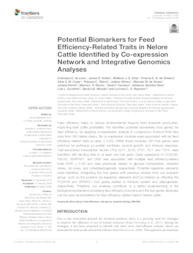Potential biomarkers for feed efficiency-related traits in nelore cattle identified by co-expression network and integrative genomics analyses.
Potential biomarkers for feed efficiency-related traits in nelore cattle identified by co-expression network and integrative genomics analyses.
Author(s): LIMA, A. O. de; KOLTES, J. E.; DINIZ, W. J. S.; OLIVEIRA, P. S. N. de; CESAR, A. S. M.; TIZIOTO, P. L.; AFONSO, J.; SOUZA, M. de S.; PETRINI, J.; ROCHA, M. I. P.; CARDOSO, T. F.; ZERLOTINI NETO, A.; COUTINHO, L. L.; MOURÃO, G. B.; REGITANO, L. C. de A.
Summary: Feed efficiency helps to reduce environmental impacts from livestock production, improving beef cattle profitability. We identified potential biomarkers (hub genes) for feed efficiency, by applying co-expression analysis in Longissimus thoracis RNA-Seq data from 180 Nelore steers. Six co-expression modules were associated with six feed efficiency-related traits (p-value ≤ 0.05). Within these modules, 391 hub genes were enriched for pathways as protein synthesis, muscle growth, and immune response. Trait-associated transcription factors (TFs) ELF1, ELK3, ETS1, FLI1, and TCF4, were identified with binding sites in at least one hub gene. Gene expression of CCDC80, FBLN5, SERPINF1, and OGN was associated with multiple feed efficiency-related traits (FDR ≤ 0.05) and were previously related to glucose homeostasis, oxidative stress, fat mass, and osteoblastogenesis, respectively. Potential regulatory elements were identified, integrating the hub genes with previous studies from our research group, such as the putative cis-regulatory elements (eQTLs) inferred as affecting the PCDH18 and SPARCL1 hub genes related to immune system and adipogenesis, respectively. Therefore, our analyses contribute to a better understanding of the biological mechanisms underlying feed efficiency in bovine and the hub genes disclosed can be used as biomarkers for feed efficiency-related traits in Nelore cattle.
Publication year: 2020
Types of publication: Journal article
Observation
Some of Embrapa's publications are published as ePub files. To read them, use or download one of the following free software options to your computer or mobile device. Android: Google Play Books; IOS: iBooks; Windows and Linux: Calibre.
Access other publications
Access the Agricultural Research Database (BDPA) to consult Embrapa's full library collection and records.
Visit Embrapa Bookstore to purchase books and other publications sold by Embrapa.

